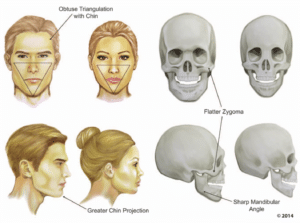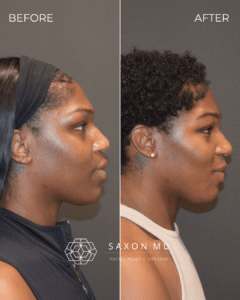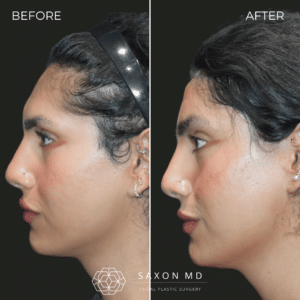Do You Have a Sloped Forehead?
Have you ever looked at your profile and felt like your forehead slopes too far back? Many people notice a sloped forehead in selfies, video calls, or even when comparing their appearance to aesthetic ideals. While some slope is normal, a sharply receding forehead can make the face appear more masculine, aged, or disharmonious—depending on your bone structure and gender.
In this blog post, we’ll explore why some people have a sloped forehead, how it differs between men and women, and what can be done to soften the profile. We’ll also touch on online discussions, anthropology, and modern surgical options for correcting this feature.
What Is a Sloped Forehead?
A sloped forehead refers to a backward-angled transition from the brow ridge to the hairline, often with minimal projection in the upper third of the face. In profile view, this slope can make the forehead appear recessed relative to the rest of the facial bones.

A helpful reference comes from the website Aryan Anthropology, which provides profile drawings that categorize forehead shapes among different ethnic and ancestral groups. These depictions show that vertical or convex foreheads are often associated with classical Greco-Roman ideals of beauty, while a sharply sloped forehead can sometimes be perceived as primitive or masculine.
Why Do Some People Have a Sloped Forehead?
There are several reasons why someone might have a noticeably sloped forehead:
Genetics: Just like nose shape or eye color, forehead angle is largely inherited. Some families tend to have more prominent brow ridges or recessed upper foreheads.
Brow Bone Prominence: A pronounced brow ridge (also called the supraorbital ridge) can exaggerate the slope between the brows and the hairline.
Lack of Upper Forehead Volume: Even without a prominent brow, a flat or underdeveloped frontal bone above the ridge can make the forehead appear recessed.
Ethnic or Ancestral Traits: Some ancestral populations, particularly those with Neanderthal admixture, are more likely to have forward-set brow ridges and a sloped forehead profile.
Interestingly, the article “An evolutionary and developmental perspective on frontal bone morphology in Homo sapiens” explores how frontal bone morphology has evolved over time. It highlights the role of the frontal sinus and cranial base angle in determining the overall projection of the forehead. According to the study, the frontal bone’s shape is influenced both by genetics and developmental factors, such as brain growth and mechanical stress on the skull.

Male vs. Female Forehead Contours
There is a clear difference in what is considered an aesthetically ideal forehead in men versus women.
Men: A slightly sloped forehead with a subtle brow ridge is typical and often associated with masculinity. However, an overly protruding brow with a steep slope can give a “Neanderthal” appearance, which some men find undesirable.
Women: A vertical or slightly convex forehead is considered more feminine. Women typically have smoother transitions from brow to hairline with minimal ridge definition. A backward-sloping forehead in a woman can create a more masculine or harsh appearance.

Real People, Real Concerns
On platforms like Reddit, there are hundreds of comments from people expressing insecurity about their sloped forehead. One user described their forehead as “caveman-like,” lamenting how it made their features look out of sync despite an otherwise delicate face. Another poster mentioned how the sloped forehead made their forehead appear overly tall and their eyebrows too deep-set, especially in side profile.
These personal accounts illustrate how even minor changes in facial angles can affect self-perception and confidence.
Options to Minimize the Appearance of a Sloped Forehead
There are both surgical and nonsurgical approaches to minimize the appearance of a sloped forehead, depending on the underlying anatomy and the degree of concern.
1. Brow Bone Reduction (Frontal Bone Contouring)
For patients with a prominent brow ridge and a backward slope, brow bone reduction can dramatically change the profile. This is often done by shaving down the supraorbital ridge and remodeling the frontal sinus area.
By setting the lower forehead back slightly and creating a more continuous vertical transition to the upper forehead, the slope becomes less pronounced. This is a common procedure in facial feminization surgery (FFS) and can have a profound effect even in cisgender patients.

2. Upper Forehead Augmentation
In cases where the brow ridge isn’t overly prominent but the upper forehead lacks volume, adding projection above the brow can create a more balanced, vertical forehead line.
Options include:
Fat Grafting: Harvested fat from the abdomen or thighs is injected into the forehead to build volume. Results are soft and natural but may require touch-ups.
PMMA (Polymethylmethacrylate): A permanent filler that can be layered gradually over several sessions. It is non-surgical but must be used with great caution.
Custom Implants: Made of silicone or porous polyethylene, these implants are surgically placed to add permanent structure to the upper forehead. This option is rare but can be helpful in extreme cases.
It’s worth noting that most patients who undergo brow bone reduction do not require upper forehead augmentation. The reshaping alone is often sufficient. Augmentation is reserved for unusual cases of extreme volume loss or flatness.
3. Dermal Fillers (With Caution)
Some medspas offer hyaluronic acid fillers to build up the forehead non-surgically. However, this should be approached with extreme caution. The forehead has a rich vascular network with connections to the retinal artery. Improper injection can lead to vascular occlusion and even blindness.
There are multiple case reports, including those cited in the Aesthetic Surgery Journal and Plastic and Reconstructive Surgery, documenting permanent vision loss following forehead or glabellar filler injections. Only experienced injectors with ultrasound guidance should attempt forehead augmentation using dermal fillers.
Combining Procedures for Best Results
Sometimes, the best results come from combining brow bone reduction with subtle volume augmentation to the upper third of the face. This approach softens the profile while restoring harmony between the upper, middle, and lower facial thirds.
Surgical planning may include a detailed CT scan to evaluate the frontal sinus, bone thickness, and safe zones for contouring. A facial plastic surgeon, like Dr. Saxon, experienced in these techniques is essential.

Natural Forehead Contours
A sloped forehead can subtly affect the balance and gender perception of your face. Whether you’re looking to soften a masculine profile, correct a feature that feels out of place, or simply feel more confident in your appearance, there are effective options available.
If you’ve been considering a change, schedule a consultation with Dr. Saxon who can help determine the best plan to meet your goals. Your forehead may slope, but your confidence doesn’t have to!
You May Also Like: